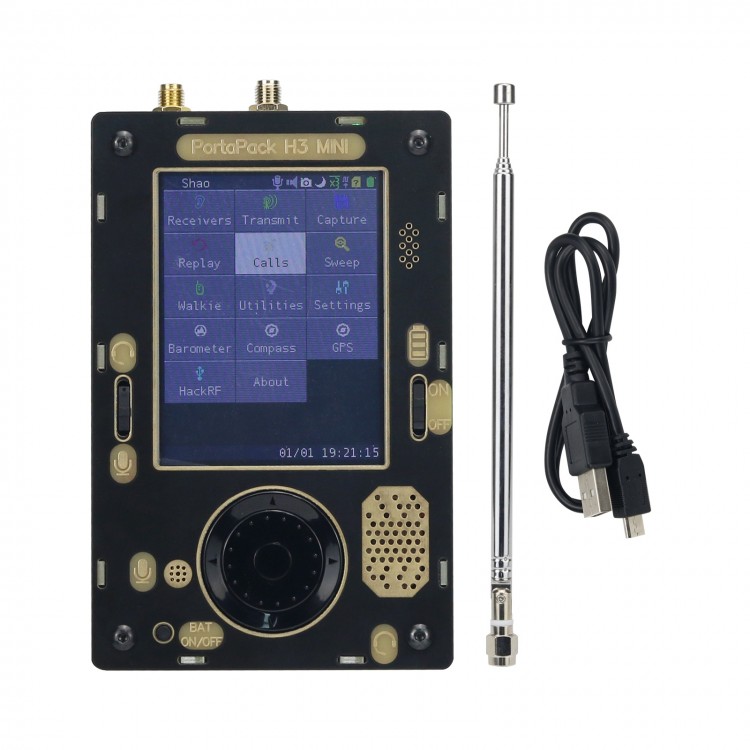
| Quantity | 3+ units | 10+ units | 30+ units | 50+ units | More |
|---|---|---|---|---|---|
| Price /Unit | $266.31 | $260.87 | $252.72 | $241.85 | Contact US |
PortaPack H3 SE & HackRF One R9 V2.0.0 Full-Featured SDR Built-in Barometer Compass GPS Receiver
Upgrades of HackRF One R9:
MAX2837 is replaced by MAX2839. Si5351C is replaced by Si5351A with additional clock distribution. A series diode is added to the antenna port power supply.
Attention:
1. The latest firmware is supported, and the current firmware is Mayhem firmware V2.0.0 by default.
2. For certain functionality, like the world map, GPS simulator, and others, you need to prepare a PortaPack H2 and a FAT32 formatted MicroSD card over 1G.
HackRF One Description:
- HackRF One is a Software Defined Radio peripheral capable of transmission or reception of radio signals from 1 MHz to 6 GHz.
-
Designed to enable test and development of modern and next generation
radio technologies, HackRF One is an open source hardware platform that
can be used as a USB peripheral or programmed for stand-alone operation.
HackRF One Specifications:
- 1 MHz to 6 GHz operating frequency
- Half-duplex transceiver
- Up to 20 million samples per second
- 8-bit quadrature samples (8-bit I and 8-bit Q)
- For GNU Radio, SDR#, and the like
- Software-configurable RX and TX gain and baseband filter
- Software-controlled antenna port power (50 mA at 3.3 V)
- SMA female antenna connector
- SMA female clock input and output for synchronization
- Convenient buttons for programming
- Internal pin headers for expansion
- Hi-Speed USB 2.0
- USB-powered
- Open source hardware
- HackRF One 1 MHz to 6 GHz SDR platform software defined radio development board
Features:
- Full function version: Including HackRF One and PortaPack H3
- SSTV (robot8, martin m1&m2, scottie s1&s2, pd-120) receiving
- NOAA receiving
- Improved Analog TV receiver (with AGC and line sync)
- Improved Signal Generator and Soundboard (added AM support)
- Built in microphone
- Built in GPS receiver for location and time sync
- Built in battery and level indicator
- Built in barometer
- Built in compass
- 3.2" screen and original thin encoder
How to use it?
Turn the red toggle switch on the right to the "on" position and press the middle button of the knob to enter the function interface of PortaPack.
Hardware Configuration:
- 3.2" TFT 240*320 screen
- Navigation switch
- Audio output
- Microphone input
- With Speaker
- 4-layer gold plate
Add a PortaPack to your software defined radio HackRF, and leave your laptop behind! The PortaPack connects to your HackRF and adds an LCD touchscreen, navigation controls, headphone jack, real-time clock, micro SD card slot.
Just add a USB battery, and you're ready to explore radio spectrum wherever you are. The PortaPack firmware works with the fast ARM processors in your HackRF. No computer is needed (except for firmware reprogramming).
Functions:
- 3.2", 240 x 320 RGB LCD with resistive touch panel
- Four-way arrow buttons, rotary wheel and select button
- Coin battery to preserve settings and date / time
- Micro SD card slot for data and storage code
- SSB, AM, narrowband FM, broadband FM audio reception, with cascade spectrum
- Broadband (18MHz) spectrum and cascade analysis
- Monitoring of boat (AIS), automobile (TPMS), E utility counter transponder (ITRON ERT)
- Calibration PPM for more accurate tuning
- Sleep mode saves energy by turning off the display only
Package Included:
- 1 x SDR Receiver
- 1 x Antenna
- 1 x USB Cable
- 1 x Bag
Precautions:
1. In order to be as thin and light as possible, PortaPack H3 uses a 900mAh lithium battery. In a typical scenario of turning on its built-in speaker (volume 90), turning on the LNA (gain 40), and listening to a radio station, the maximum endurance time is 80 minutes.
2. It needs to be powered on while charging. First plug in a USB power bank in the off state, and then turn on the battery switch. At this time, you can find out that there is an orange LED inside the device staying on, and the battery power icon in the upper right corner will turn orange, green and blue. When the battery is fully charged, the orange LED will be off or flashing. At this time, please unplug the USB cable and stop charging.
3. There is no filter before the RF Gain of HackRF, and the signal of any frequency band entering from the antenna will be amplified. For example, if you only want to amplify the signal of the FM frequency band, but there is a strong WiFi signal around you, it will also be amplified, which may damage the HackRF, so it is recommended not to increase the RF Gain excessively, that is, do not set the LNA gain too high.
4. This device is designed for experimental and entertainment purposes, please abide by relevant national regulations when using it.






